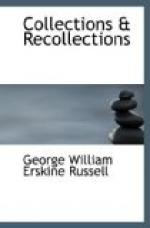While the prevailing tone of quiet worldliness was thus broken, here and there, by horrid scandals, in other places it was conspicuously relieved by splendid instances of piety and self-devotion, such as George Eliot drew in the character of Edgar Tryan of Milby. But the innovating clergy of the Evangelical persuasion had to force their way through “the teeth of clenched antagonisms.” The bishops, as a rule, were opposed to enthusiasm, and the bishops of that day were, in virtue of their wealth, their secular importance, and their professional cohesiveness, a formidable force in the life of the Church.
In the “good old days” of Erastian Churchmanship, before the Catholic revival had begun to breathe new life into ancient forms, a bishop was enthroned by proxy! Sydney Smith, rebuking Archbishop Howley for his undue readiness to surrender cathedral property to the Ecclesiastical Commission, pointed out that his conduct was inconsistent with having sworn at his enthronement that he would not alienate the possessions of the Church of Canterbury. “The oath,” he goes on, “may be less present to the Archbishop’s memory from the fact of his not having taken the oath in person, but by the medium of a gentleman sent down by the coach to take it for him—a practice which, though I believe it to have been long established in the Church, surprised me, I confess, not a little. A proxy to vote, if you please—a proxy to consent to arrangements of estates, if wanted; but a proxy sent down in the Canterbury Fly to take the Creator to witness that the Archbishop, detained in town by business or pleasure, will never violate that foundation of piety over which he presides—all this seems to me an act of the most extraordinary indolence ever recorded in history.” In this judgment the least ritualistic of laymen will heartily concur. But from Archbishop Howley to Archbishop Temple is a far cry, and the latest enthronement in Canterbury Cathedral must have made clear to the most casual eye the enormous transformation which sixty years have wrought alike in the inner temper and the outward aspect of the Church of England.
Once Dr. Liddon, walking with me down the hall of Christ Church, pointed to the portrait of an extremely bloated and sensual-looking prelate on the wall, and said, with that peculiar kind of mincing precision which added so much to the point of his sarcasms, “How singular, dear friend, to reflect that that person was chosen, in the providential order, to connect Mr. Keble with the Apostles!” And certainly this connecting link bore little resemblance to either end of the chain. The considerations which governed the selection of a bishop in those good old days were indeed not a little singular. Perhaps he was chosen because he was a sprig of good family, like Archbishop Cornwallis, whose junketings at Lambeth drew down upon him the ire of Lady Huntingdon and the threats of George III., and whose sole qualification




